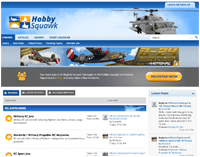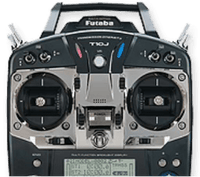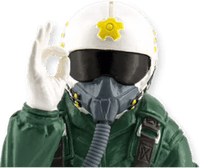Proper Landing Techniques For Jets
von Motion RCProperly landing an EDF jet is one of the most rewarding moments in all of RC flying. Jets always get the blood pumping with their speed and performance in the air. When you successfully "grease" a scale landing with a jet, it sticks with you for the rest of the day. On the other hand, no matter how great the flight was, if you goof up the landing - or worse, damage the plane - upon touchdown, the whole flight feels ruined.
Here are some techniques and tips to help keep your EDF jet landings a happy event worth celebrating.
Plan Your Approach
Just like with any plane, you want to establish a pattern. Takeoff leg, crosswind leg, downwind leg, base leg and final. This rectangular flight pattern is common throughout all of aviation and helps you visualize when to perform certain tasks in the air. Since this article is about landing specifically, we will focus on the portions of the pattern relative to that action.
When you are ready to land, you want to drop your gear (assuming your EDF jet has retracts as most do these days) somewhere around the entry into the downwind leg. This is also a good time to drop your first level of flaps (assuming your EDF jet has flaps and you have more than one setting of flap degree programmed). Manage your throttle and elevator accordingly.
As you prepare to enter the base leg, drop your flaps to their full setting assuming there's not an overabundance of headwind. The flaps increase drag and lift. This allows you to slow the plane down as well as not gain too much speed if you are establishing a steep approach.
Final Approach - Manage The Throttle
The key with jets is keeping some speed all the way to the ground. Dead-sticking on final approach is usually asking for trouble as many jets don't generally have gentle stall characteristics. Jets need speed over the control surfaces to be effective throughout the entire flight envelope. To avoid stalling on the final approach, you want to keep between 15%-25% power on. Throttle is also used to control altitude. If your jet is properly trimmed with flaps, you can manage the approach with throttle and very little use of elevator.
Some jets like the smaller (64mm-70mm) F-16 and F-18 among others actually have good glide properties so it's possible to dead stick those jets assuming you are keeping them above stall speed all the way to the ground. However, it's not good practice to dead stick 90mm-sized EDF jets due to their increased weight and wing loading.
If you find yourself using the elevator aggressively or quite a bit on final approach, you are likely not using the throttle to your advantage. One of the key misunderstandings of power is that it is simply to increase speed. The truth is, the throttle is also meant to adjust altitude. The elevator is there to adjust pitch with authority, such as flaring right before the touchdown.
Fly Her To The Ground
Now you have established a good glide slope and speed on your final approach path. You have flaps according to your environment (less flaps are needed in higher head winds) and your gear is down. This is the point that you simply fly her to the ground. How do you do that? Keep the nose relatively parallel to the ground. Manage your throttle and elevator to achieve a speed that is flying comfortably just above stall speed. If she begins to feel "mushy" on the sticks, increase your power a bit. You don't want the nose too low or too high above the horizon line.
Some jets like the F-16 actually prefer a higher AoA (Angle of Attack) on final approach. The key is keeping the jet above stall speed at all times until the flare, inches above the surface.
Once you get her close to ground effect (half the total wingspan's length between the ground and the jet) begin to lower your power. Once you are under a foot or so from the ground begin to decrease your power even more and ever-so-gently raise the nose with elevator to establish a good flare. You don't want to literally fly the jet into the ground, but you do want to be committing the act of active flying all the way until touchdown and then throughout the rollout.
Grass or Paved?
Both surfaces provide there own challenges. Some folks don't have the luxury of a long, paved runway surface to fly their model aircraft. Often grass is the only choice. The general rule of thumb when considering if you can fly your jet on grass is if more than 1/3 of a wheel's height is covered in grass, the model likely will not takeoff due to too much resistance. Many folks remove the gear from their jets if their only chance to fly is on a grass field. They become known as "hand tossers" or "belly landers". These are usually the 64mm-70mm size class as their weight and size makes it easier to hand toss where the 90mm class are generally too heavy and large for successful hand tossing.
Summary
So to summarize, establish your pattern, drop your gear and flaps according to your environment and location in the pattern, line the jet up on final approach and manage the throttle to adjust altitude and a safe speed just above the stall speed. Fly the jet all the way to the ground, easing off on the throttle as you slowly raise the nose for the flare inches (not feet) above the ground.
Like with anything, a good jet landing requires practice. Once you have established the fundamentals, the muscle memory will follow and before you know it, you're thinking less and reacting based on sound principles that should satisfy for years and years to come.
Happy Landings!
Get the latest from Motion RC sale and product announcements
You can unsubscribe at any time!

Hobby Squawk Community Forum
visit forum
RC Knowledge Blog
visit blog
Guidance & advice for beginners
Find out more- Wenn du eine Auswahl auswählst, wird eine vollständige Seite aktualisiert.
- Drücke die die Leertaste und dann die Pfeiltasten, um eine Auswahl zu treffen.
